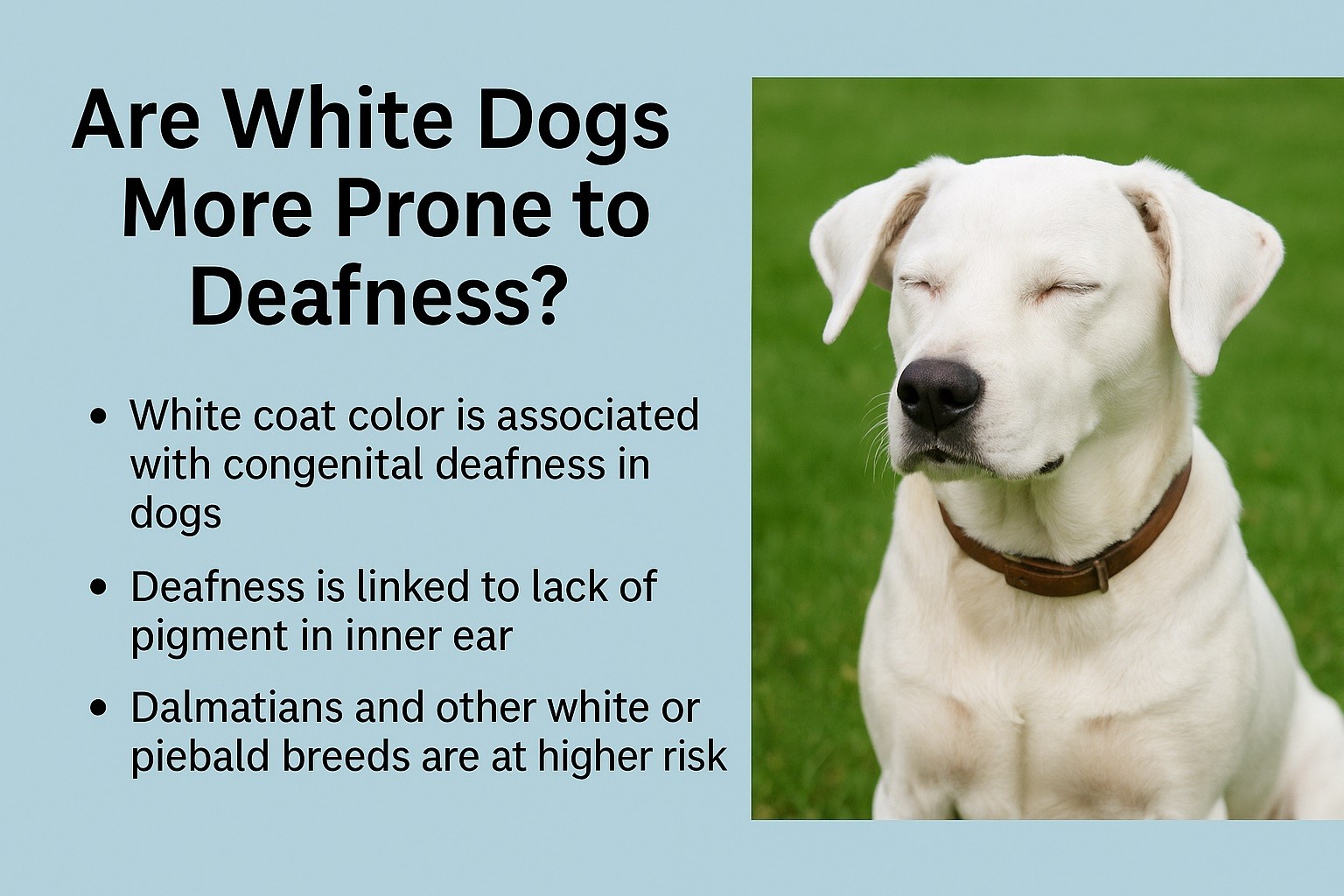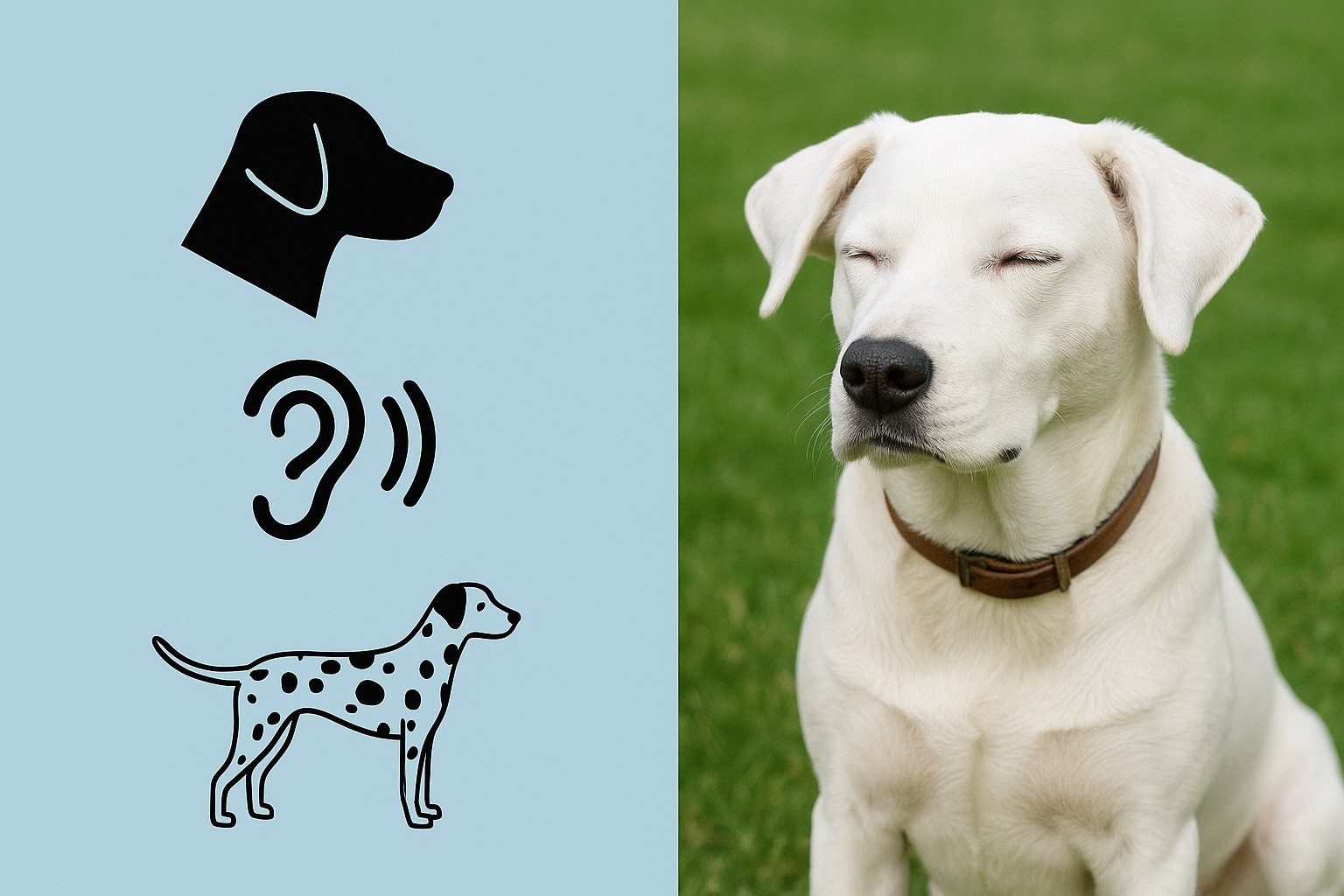White-coated dogs are undeniably striking, but many owners and prospective adopters wonder: Are white dogs more prone to deafness?
The answer lies not in coat color itself, but in genetics, specifically, how pigmentation genes affect inner ear development.
This article explains the connection and offers breed-specific insights for informed ownership.

How Hearing Works—and What Goes Wrong
Sound perception begins when vibrations reach the cochlea in the inner ear. There, tiny hair cells convert mechanical waves into electrical signals transmitted to the brain.
Loss of these hair cells results in sensorineural deafness, which is typically irreversible. Many congenital deafness in dogs are linked to pigmentation genes.
In the inner ear’s stria vascularis, melanocytes—pigment-producing cells—are essential for maintaining the environment around hair cells.
Absence of melanocytes leads to degeneration of those hair cells, causing deafness fidosbark.com
Genes Behind the White Coat
Two primary genetic mechanisms link white coats to deafness:
Piebald/Splashed-White Genes
These genes cause large white patches or nearly all-white coats by reducing melanocyte presence.
Dalmatians, Bull Terriers, Boxers, English Setters, and Jack Russell Terriers often display piebald patterns.
When melanocytes are absent from the inner ear, deafness becomes more likely
Merle Gene and “Double Merle”
The merle allele—found in breeds like Australian Shepherds, Catahoulas, Dachshunds, Cardigans, and Great Danes—alters color patterns.
Dogs possessing two merle alleles (“double merles”) can be nearly white, and frequently suffer from deafness, eye defects, or both en.wikipedia.org.
Breed-Specific Data
Dalmatians
Studies report 16–25% of Dalmatians suffer deafness in one or both ears.
While traditionally associated with white spots and blue eyes, recent research indicates other genes also contribute.
Boxers
White Boxers—those with excess white pigmentation—are predisposed to deafness.
Roughly 18% are deaf in one or both ears, and rescue groups often report even higher numbers.
Bull Terriers, English Setters, Jack Russell Terriers
Although concrete statistics are limited, dogs from piebald-color breeds—including Bull Terriers, English Setters, and Jack Russells—carry a higher deafness risk.
Merle-Patterned Breeds
Merle dogs carry a moderate deafness risk, but “double merles” face a dramatic increase.
One study found 9% of double merle Dachshunds were deaf in both ears; up to 55% had partial hearing loss.
In Double Merle Australian Shepherds and Great Danes, high rates of hearing and vision defects are common.
Australian Cattle Dogs & Catahoulas
Australian Cattle Dogs (with piebald alleles) showed a hearing-loss prevalence of about 10.8 %.
Catahoulas, often merle-patterned, see deafness in about 8%, including unilateral and bilateral cases.
Why Blue Eyes Often Co-occur with Deafness
Blue eyes in dogs frequently indicate a lack of melanin in the iris and other tissues. This pigment deficiency can also affect the inner ear.
Thus, dogs with blue eyes often carry the same genetic mutation that predisposes them to deafness.
However, blue eyes alone are not definitive proof of hearing impairment.
How Deafness Is Diagnosed
Owners may suspect deafness if their dog:
- Doesn’t respond to its name or loud noises
- Sleeps through typical household sounds
- Reacts to human touch instead of voice cues
To confirm, veterinarians administer the BAER (Brainstem Auditory Evoked Response) test.
Electrodes record brainwave activity from auditory stimuli, reliably diagnosing unilateral or bilateral deafness fidosbark.com.
Accommodating a Deaf Dog
Deaf dogs can enjoy full, enriching lives with proper adaptation:
- Visual Communication – Teach hand signals instead of verbal commands. Deaf dogs respond well to clear visual cues.
- Safety Precautions – Use leashes, fenced areas, and caution near traffic, since deaf dogs cannot hear approaching danger.
- Vibration & Light Cues – Vibration collars and flashlights work well as attention-getters.
- Consistent Routines – Predictability offers reassurance to deaf pups.
- Positive Reinforcement – With patience and rewards-based training, deaf dogs can excel at agility, tricks, and obedience using non-auditory cues.

Breeding: Ethics & Prevention
No DNA test for pigment-associated deafness exists yet; breeders rely on BAER results and selective pairings.
Avoid breeding double merles; reputable organizations now discourage merle-to-merle pairings merckvetmanual.com.
BAER testing before breeding ensures healthier litters and reduces congenital deafness.
The Dalmatian and Boxer clubs recommend breeding only from bilaterally hearing dogs.
Myths & Misconceptions
“All white dogs are deaf.” False—for example, most white Boxers have normal hearing.
“Blue eyes mean deafness.” Overgeneralized; many healthy blue-eyed dogs are normal-hearing.
“Deaf dogs can’t live normal lives.” Wrong—a deaf dog, with proper adjustments, can thrive and form deep bonds just like any other pet fidosbark.com.
Comparison: White and Merle-Coated Dog Breeds & Deafness Risk
| Breed | Main Coat Genetics | Deafness Prevalence | Common Eye Color | Notable Details |
|---|---|---|---|---|
| Dalmatian | Piebald spotting (extreme white) | Up to 30% (bilateral + unilateral) | Often blue or brown | One of the most studied breeds for congenital deafness. High genetic predisposition. |
| Boxer (White variant) | Piebald (excessive white) | ~18% overall; more in rescue cases | Dark or blue eyes | White Boxers are often sterilized or not bred to reduce deafness risk. |
| Bull Terrier (White) | Piebald or dominant white | ~20% suspected (not consistently studied) | Often dark | White coat strongly associated with hearing issues. |
| English Setter | Piebald with ticking | Estimated ~10–15% | Dark or amber | Deafness found mostly in field lines with heavy white spotting. |
| Australian Shepherd | Merle (blue or red merle) | 5–10% (single merle); 25–50% (double merle) | Blue or heterochromatic | Double merles are at much higher risk and often visually impaired as well. |
| Great Dane (Harlequin) | Merle base + Harlequin gene | Higher in double merles | Blue or mismatched | Harlequin pattern can mask risks; double merles are often born blind/deaf. |
| Dachshund (Dapple) | Merle gene (dapple) | 5–15% in double dapples | Variable | Double dapples especially at risk; not advised for breeding. |
| Catahoula Leopard Dog | Merle pattern with varied pigmentation | ~8% reported | Blue or marbled | Deafness more frequent in those with high white content or merle × merle pairings. |
| Jack Russell Terrier | Piebald spotting | Low to moderate (varies by line) | Dark | Some lines show increased risk when predominantly white. |
| Border Collie (Merle) | Merle gene in some lines | Rare, but higher in double merles | Often blue in merles | Deafness uncommon in standard black-and-white variants. |
Conclusion
White-coat coloring in dogs is not harmless when tied to specific pigmentation genes such as piebald or merle.
Breeds like Dalmatians, Boxers, Bull Terriers, and merle-patterned dogs like Australian Shepherds or Catahoulas are at higher risk.
But hearing impairment doesn’t define a dog's quality of life—BAER testing, careful breeding, and considerate training can empower deaf dogs and owners alike.




















